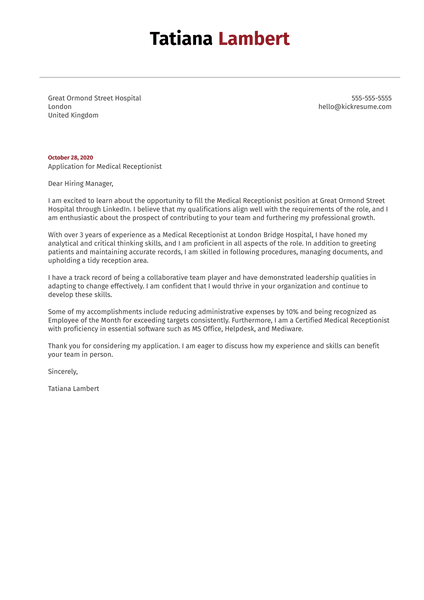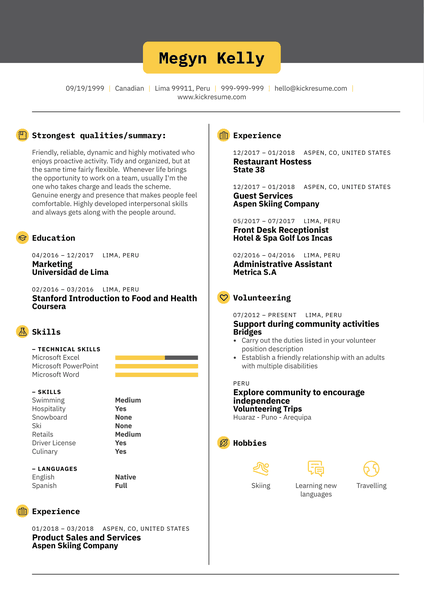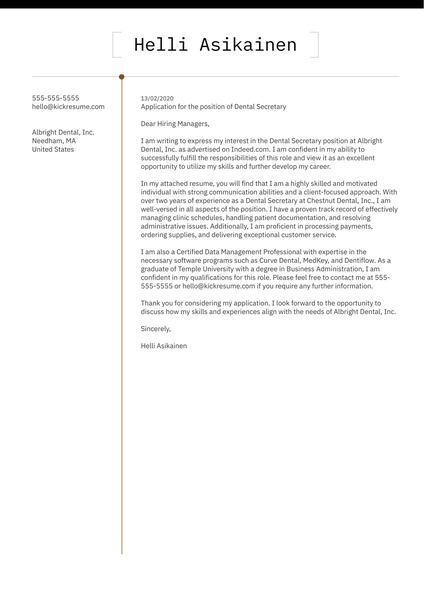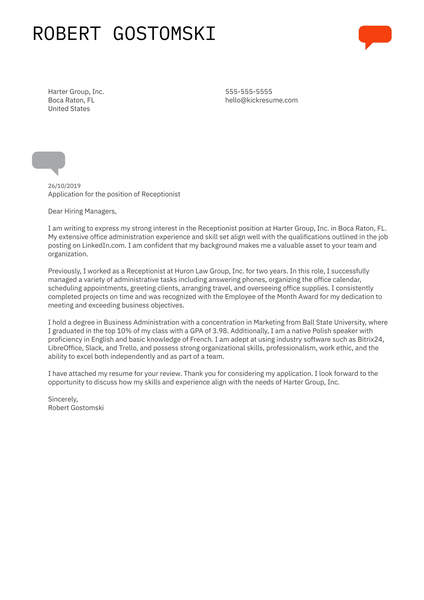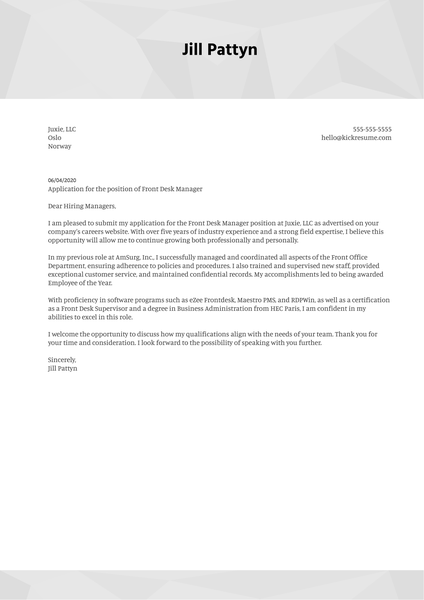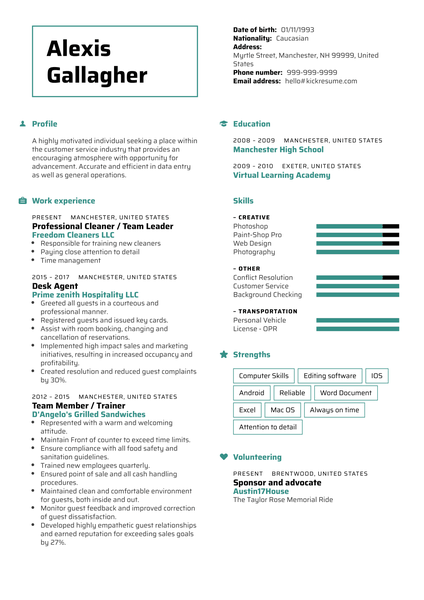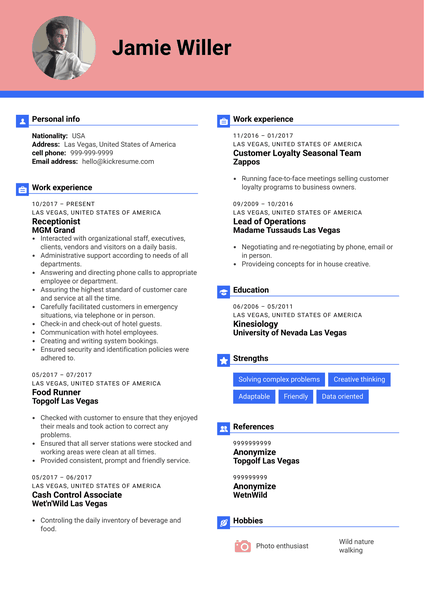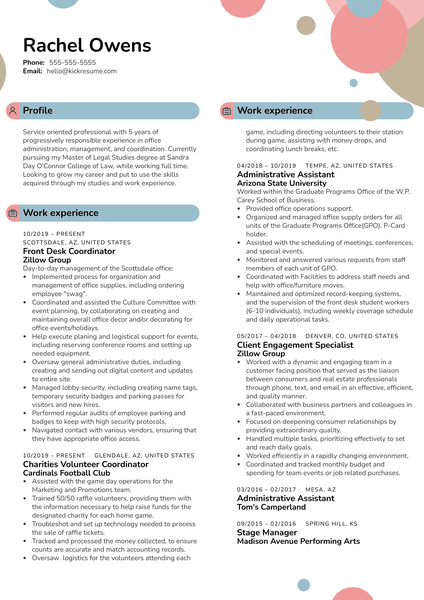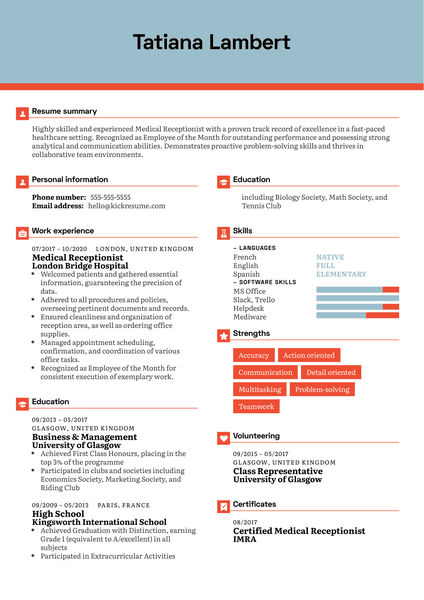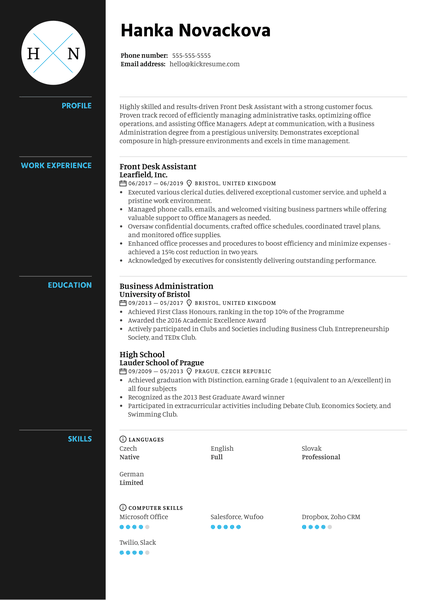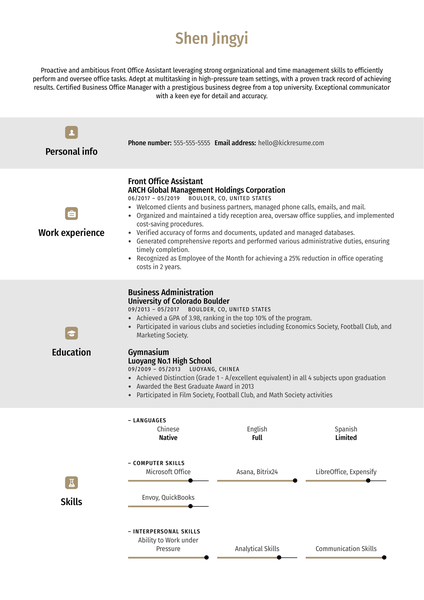Charting a successful career as a front desk receptionist starts with an impeccable cover letter. Like a well-handled switchboard, it's about delivering the right messages — your skills, qualifications, and unique value — to your prospective employer.
This guide breaks down how to achieve exactly that, packed with essential tips, illustrative examples, and intuitive templates.
Read on and discover all about:
- Formatting your front desk receptionist cover letter
- Designing an effective header
- Generating a persuasive headline for your cover letter
- Personalizing the greeting in your front desk receptionist cover letter
- Crafting a powerful introduction for your cover letter
- Showcasing your receptionist skills and achievements
- Writing a compelling conclusion to your cover letter
- Avoiding common mistakes in your front desk receptionist cover letter
- Understanding the average salary and job outlook for receptionist roles
- Discovering useful resources for front desk job seekers
1. How to properly format your front desk receptionist cover letter
A well-formatted cover letter is much like an organized desk — everything is in its place, making it easy to locate, understand, and appreciate.
Here are some handy tips on how to ensure a smooth read while keeping it professional:
- Standard business letter format: Stick to this traditional structure. This will include your contact details, the date, employer's contact details, greeting, body of the letter, closing statement, and your signature.
- Length: Short and sweet is the key. Ideally, keep the cover letter to one page.
- Readable font and size: Opt for a professional, clean font — think Arial or Times New Roman. Size-wise, 11pt or 12pt should do the trick.
- Margins and spacing: Use standard 1-inch margins. Single or 1.5 line spacing keeps your text just airy enough to invite the reader in.
- Alignment: Alignment matters. Left alignment looks neat and offers consistency.
- Consistency: Ensure your styling remains the same throughout the cover letter. This includes font size, bullet style, indentation, etc.
Remember, a well-structured cover letter can demonstrate your organizational skills before you even step foot in the interview room. Don't overlook this detail!
2. How to write an effective cover letter header
The header of your cover letter is basically your business card — it presents key contact information upfront. It consists of your contact details and those of your prospective employer. And as it's the first thing the hiring manager sees, it’s important to get it right.
Your cover letter header should feature:
- Your full name
- Your physical address
- Your phone number
- Your professional email address
- Up-to-date LinkedIn profile (optional, but recommended)
- The date
- The recipient’s name
- Their title
- Company name
- Company address
Now let's look at two contrasting examples to clarify these points:
Weak cover letter header example
John Doe
john@email. com
123 Main Street
Why doesn’t it work? This header seems rushed and incomplete. Notice the unconventional spacing in the email, the omission of John's phone number, city, state, and zip code, and the absence of LinkedIn details. Furthermore, not including the hiring manager's details can seem careless or impersonal to the reader.
Correct cover letter header example
John Doe
123 Main Street
City, State, Zip
Phone number
john.doe@email.com
https://www.linkedin.com/in/john-doe
[Date]
To: Ms. Jane Smith
HR Manager
Company XYZ
456 Market Street
City, State, Zip
Why is it strong? By including thorough contact information, John is inviting the potential employer to reach out via multiple channels. The presentation is clean and professional.
Additionally, by addressing Jane Smith directly and including her job title and company’s details, John creates a personalized touch showing he has taken time to research the recipient. This shows respect for the employer and distinguishes the job application.
All in all, a correctly formatted header serves as your first impression. Remember, being detailed and professional in your header sets the tone for the rest of your cover letter, demonstrating that you're serious about your application. Use the correct example as your model and you'll be on the right track.
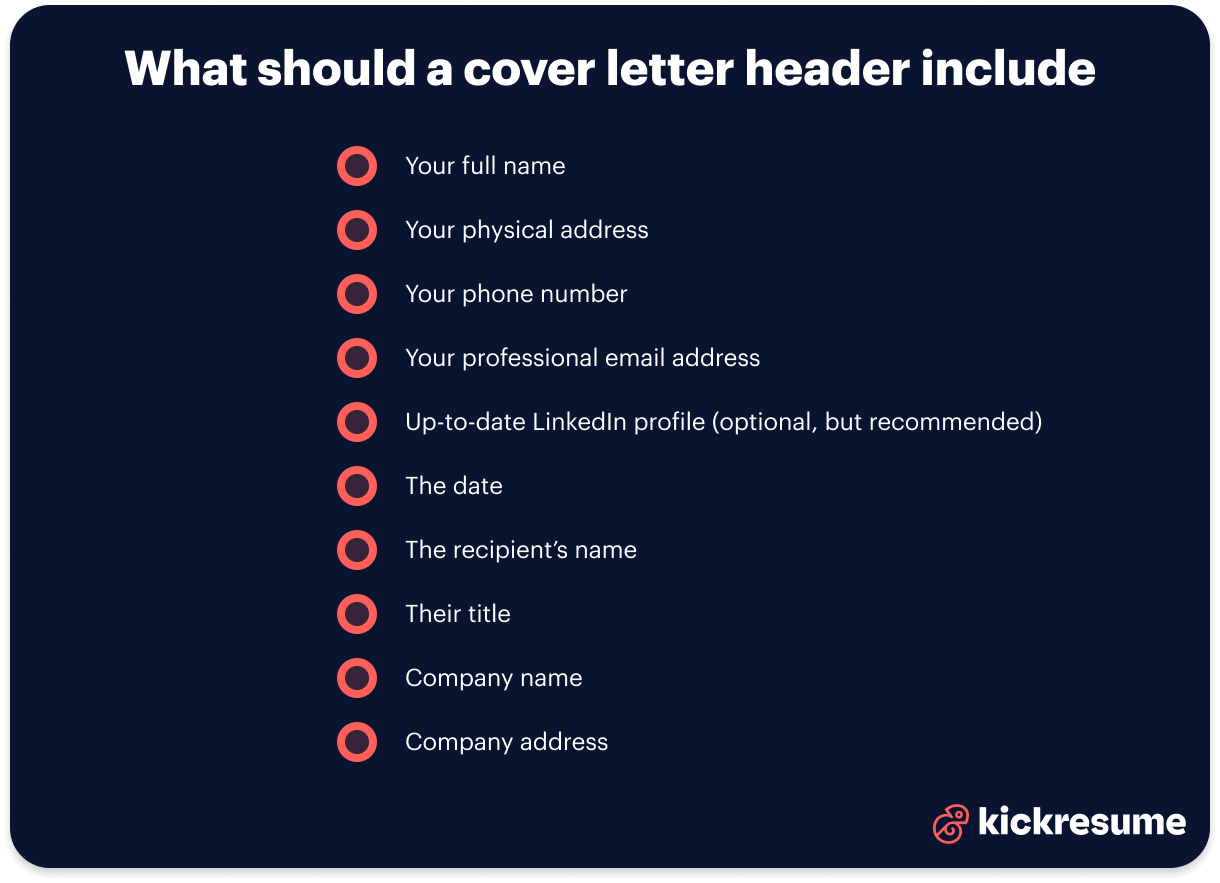
3. How to write a compelling cover letter headline
Creating a compelling headline for your receptionist cover letter is your chance to briefly encapsulate your professional story. It is the hook that intrigues the hiring manager to read further.
A strong headline clearly states your career identity and the value you offer. As a receptionist, the headline should highlight your skills, experience, or notable achievements related to office administration or guest relations.
Let’s check out two contrasting examples:
Weak cover letter headline example
Applying for the Receptionist position
Why does it fall short? This headline is too basic. It merely states the intention to apply, which we’ve already known. It doesn’t provide a snapshot of your skills, experience, or the unique value you bring to the role.
Strong cover letter headline example
Seasoned Front Desk Receptionist Offering Stellar Customer Service and Proven Administrative Expertise
Why is it strong? This headline conveys a greater sense of professionalism. It communicates your experience and high degree of customer service skills, creating an instant robust professional image.
But what if you're a fresh graduate? Don’t worry, your headline could look something like this:
Strong cover letter headline example for a fresh graduate
Dedicated Communications Graduate Eager to Excel as a Front Desk Receptionist
Why does it work? Graduates might not have an extensive work history, but a strong headline can still highlight your dedication, field of study, and determination to succeed in the role. This headline sends a strong signal about your potential value to the organization.
Pro tip: Consider integrating relevant keywords from the job posting into your headline. This can make your cover letter more eye-catching to hiring managers and can help you get past applicant tracking systems (ATS) used by many companies to filter applicants based on keyword matches. However, always ensure that the keywords match your actual skills and expertise — integrity is key.
Remember, your headline should be a point of interest that kindles curiosity about your profile. Use it wisely to establish your value proposition upfront.
4. How to tailor the greeting on your cover letter
Addressing your front desk receptionist cover letter with a personalized greeting can surely demonstrate your attention to detail. It shows you've done your homework and it helps establish an immediate connection with the reader.
If you wonder where to find the name of the hiring manager or recruiter, the solution might be closer than you think. Look at the job listing where it may be mentioned. If not, the company website, LinkedIn, or even a quick phone call to the company can help you find out who will be reading your letter.
Personalized greeting examples
- Dear Mr. Smith,
- Dear Mr. John Smith,
- Dear Hiring Manager John Smith,
If you've tried everything and still can't find a specific name, here are some general greetings you can use:
General greeting examples
- Dear Hiring Manager, — This is a reliable standby. It's formal and direct.
- Dear [Department] Team, — Here's a slightly creative approach. This is best used when you know your application will be screened by a specific department.
Avoid using outdated or overly impersonal greetings like “To Whom It May Concern,” or “Dear Sir/Madam,”. The modern hiring process prefers a more personalized approach.
Remember, the goal of customizing the greeting is to make the reader engage with your letter. So spend a few minutes to identify the right name or title — it’s worth the effort.
5. How to write a strong opening to your receptionist cover letter
Your cover letter's opening paragraph should draw in the reader much like a compelling book's first line. It should present an overview of your professional and academic history, state why you're applying for the role, and, if applicable, mention any mutual connections.
Let’s take a look at some contrasting examples:
Incorrect cover letter opening example
I'm writing to apply for the front desk receptionist position. I have worked as a receptionist before and I am confident I can do the job.
Why does it fall flat? This opening simply lacks detail and does not provide a compelling reason for the reader to continue. It fails to mention specifics of prior experience, why the applicant is interested in the job, or what unique value they would bring to the role.
Strong cover letter opening for an experienced receptionist
With over five years of experience managing front desk operations in fast-paced environments, I bring a proven ability to deal with diverse customer situations. I'm drawn to XYZ Company's commitment to customer service excellence and believe that my skill set would be well-aligned with your requirements.
Why does it work? This example quickly identifies noticeable experience, a key strength, and a direct connection between the candidate's expertise and the company's needs.
Strong cover letter opening for a recent graduate
As a recent graduate in Hospitality Management with an honors distinction, I offer a strong academic background and a passion for customer service. I am interested in the receptionist role at XYZ Company, as I believe my skills would foster a welcoming and efficient front desk environment.
Why is it effective? Even without any professional experience, this graduate makes an impact by highlighting strong academic credentials, directly related to the job, their passion for the work, and how this matches up with the company's needs.
Remember, a well-composed opening makes it more likely for the hiring manager to continue reading your application. Capture their interest from the get-go and the rest of your letter will likely receive the attention it deserves.
6. How to highlight your top skills and accomplishments
When crafting the body of your front desk receptionist cover letter, payoff comes from the perfect blend of storytelling and evidence-based achievements.
Think of it as a showcase window, offering a glimpse into your professional journey and reinforcing why you're an ideal fit for the role.
To properly highlight your skills and achievements:
1. Format the body correctly: This part of the cover letter should be organized into short, readable paragraphs. Consider 2-3 paragraphs, each focusing on a different aspect of your qualifications.
2. Mention relevant skills:Tailor your letter for the role, emphasizing relevant skills and competencies.
Here are some skills to mention in your receptionist cover letter
- Excellent communication and interpersonal skills
- Strong customer service and conflict resolution abilities
- Proficiency in administrative software (list specific programs if applicable)
- Time-management and organizational skills
- Multitasking and prioritization capabilities
- Professional and courteous demeanor
3. Showcase specific achievements: Rather than just listing duties in your previous roles, focus more on what you achieved. Did you improve the process? Solve a persistent issue? Earn recognition for outstanding service?
Cover letter body paragraph example for an experienced receptionist
Serving as a front desk receptionist at ABC Hotel, I developed strong customer service and conflict resolution skills that positively impacted guest experience. I consistently managed interactions with over 100+ guests daily, maintaining a high satisfaction rate and contributing to the hotel's reputation for excellent service. My dedication to effective communication and problem-solving led to being recognized as 'Employee of the Month' three times. I am excited to bring these capabilities to XYZ Company to enhance guest satisfaction and contribute to your team's success.
Why is it effective? This paragraph precisely tells the applicant's experience, shows relevant skills in use, and provides substantial evidence of excellence in the role. What’s more, it directly addresses how their skills and achievements can add value to the future employer's business.
No work experience yet? Fear not! Highlight transferable skills, academic achievements, internships, or volunteerships. Mention relevant modules you excelled at during your studies or any extra-curricular activities showing your leadership or organizational capabilities.
Cover letter body paragraph example for a fresh graduate
As a recent business graduate from XYZ University, I have gained strong skills in communication, administration, and customer service through various internships and on-campus involvements. As the team leader for our final year project, I coordinated the tasks of five team members, meeting all deadlines and achieving a final grade of A+. This experience taught me the value of clear communication and effective organizational skills.
Why does it tick all the boxes? This paragraph shows how academic and leadership experiences have equipped the candidate with relevant, transferable skills. Moreover, it subtly hints at how these honed abilities, such as clear communication and effective organization, can be transferred to the benefit of the potential employer in a front desk receptionist role.
Remember, for the body of your cover letter, it's quality, specificity, and relevance that matter.
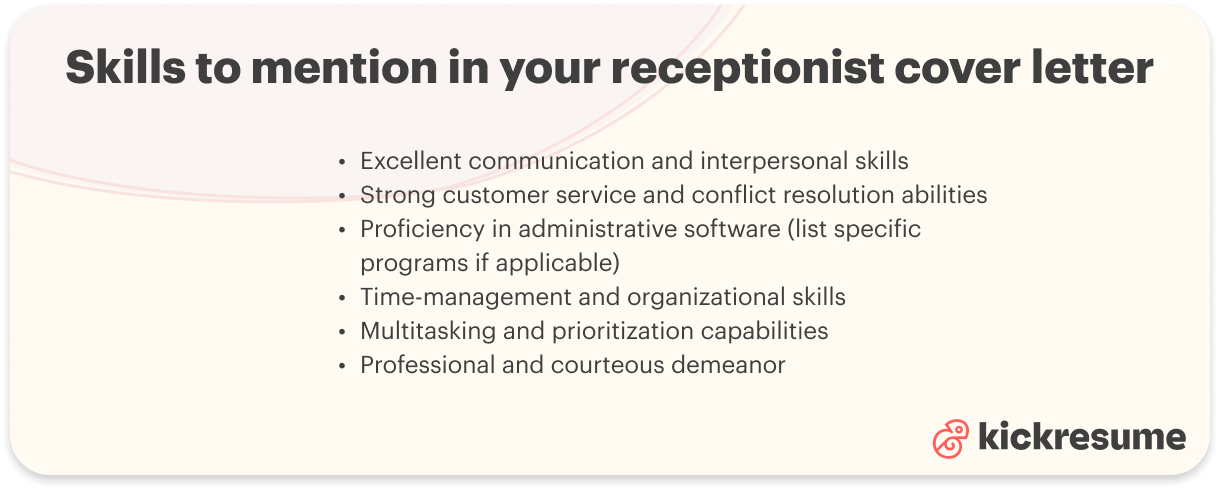
7. How to persuasively end your receptionist cover letter
The conclusion of your cover letter serves as your final opportunity to leave a memorable and positive impression. It's your closing argument, reiterating your interest in the role, inviting further interaction, and expressing appreciation for the reader's time.
An effective conclusion should include:
- A reiteration of your interest in the position and the company
- Your preferred contact method and any time restrictions, if necessary
- Your intention and timeline for follow-up
- A professional sign-off
Incorrect cover letter conclusion example
Please call me anytime. Thanks.
Kind regards,
[Your Name]
Why is it wrong? This conclusion is considerably weak. It lacks professionalism, doesn't convey genuine interest in the position or the company, and neglects to mention any follow-up actions.
Correct cover letter conclusion example
I am eager for the opportunity to share more about how my strong reception and customer service skills could be a valuable asset for XYZ Company. You can reach me anytime on my cell at (123) 456-7890, or via email at candidate@example.com. If I haven't heard back by next week, I will touch base to follow up.
Thank you for considering my application.
Sincerely,
[Your Name]
Why is it strong? This example shows the candidate's keen interest in the role and clearly communicates their readiness to discuss how their skills could meet the company's needs. The candidate also takes a proactive strategy by setting a timeline for following up if they don't hear back. The sign-off is professional, maintaining a high level of respect throughout.
The conclusion of your cover letter can indeed leave a lasting impression on recruiters. It’s an opportunity to express your sincere interest in the role and leave the recruiters keen to learn more about your potential fit within the company.
8. How to avoid common mistakes on a receptionist cover letter
It's crucial to remember that every detail in your receptionist cover letter contributes to the impression you make. Avoiding common mistakes can help ensure your application stands out for all the right reasons.
Here are a few pitfalls to dodge:
- Avoid generic phrases: Phrases like "I'm a hard worker" or "I'm a team player" are clichés that don't effectively communicate your skills. Instead, illustrate these qualities with specific examples from your experience.
- Incorrect: "I'm a dedicated worker."
- Correct: "My dedication to customer service was recognized when I received the 'Employee of the Month' award twice at my previous job."
- Don't neglect proofreading: Spelling mistakes, punctuation errors, or inconsistent tense usage can undermine your professionalism. Make sure to carefully proofread your cover letter. Consider using online grammar tools or asking a friend to help review it.
- Skip salary discussion: Your cover letter is not the place to negotiate salary or benefits. These discussions are more apt post-interview when the employer has shown interest in your candidacy.
- Avoid negativity: Talking negatively about a past employer or job experience sends the wrong signal. Focus on your positives, what you learned, and how you can bring value to the new role.
- Too much, too little: Avoid overstuffing with unnecessary details. Balance is key — provide just enough info to entice the reader to want to know more.
Dodging these common mistakes can make your cover letter a powerful tool, clinching the crucial attention of recruiters. Be sure to double-check, hold back on cliches, and remember to keep it professional yet personable, just as a receptionist would at the front desk.
9. Average salary and job outlook for front desk receptionists
Understanding the salary and job outlook for front desk receptionists can provide valuable context as you're tailoring your application.
As per the most recent data from the Bureau of Labor Statistics (BLS), the median annual salary for receptionists was $33,960 in May 2022. This number can widely vary depending on the industry, region, and level of experience.
When considering the job outlook for front desk receptionists, the BLS is indicating little or no change in employment from 2022 to 2032.
But don't be disheartened by the steady forecast. There's a promising aspect to consider: about 142,600 openings for receptionists are projected each year, on average, over the next decade. These positions are often created when workers retire or move on to different roles.
So, even though job growth might stabilize, your exceptional cover letter could still land you one of the many opportunities arising each year. The market for an exceptional front desk receptionist remains active.
10. Top resources for aspiring receptionists
Becoming a successful front desk receptionist is a journey that involves continual learning and development. Luckily, numerous resources can support you along the way.
- Industry news: Keep up with industry trends by following reputable news sites and blogs like the American Society of Administrative Professionals (ASAP) and Office Dynamics International.
- Webinars and online courses: Websites such as Lynda.com, Coursera, and Udemy offer a multitude of courses. Topics range from customer service, technology skills, to office management.
- Professional associations: Joining groups like the International Association of Administrative Professionals (IAAP) can provide networking opportunities, and access to a wealth of resources and continuing education.
- Books: Boost your skill set with titles such as "The Exceptional Receptionist: Your Company's Most Valuable Asset" by Paul R. Timm or "Be A Kickass Assistant" by Heather Beckel.
- Job Boards: Aside from large job boards like LinkedIn or Indeed, also consider industry-specific options like the Association of Executive and Administrative Professionals (AEAP) job board.
- Networking: Connecting with other receptionists and office professionals can prove invaluable. Look at local events, LinkedIn groups, and online forums to engage with others in your field.
- Career development platforms: Platforms like Kickresume, JobHero and The Muse offer resume templates, cover letter tips, and career advice specifically tailored for aspiring receptionists. Keeping your application materials polished and up-to-date can increase your chances of getting that coveted receptionist role.
Remember, successful job hunting is not solely about the perfect cover letter or resume — there's much more. Immerse yourself in the industry, keep learning, and use these resources to help you stand out as a highly skilled front desk receptionist.
Front Desk Receptionist Cover Letter FAQ
How should I address a cover letter if I don't know the hiring manager's gender?
If you can't determine the hiring manager's gender, it's best to use their full name. For example, 'Dear Jordan Smith,'. If you don't have a name, stick with a generic but professional greeting like 'Dear Hiring Manager,'.
Should I include my salary expectations in my cover letter?
Unless the job posting specifically asks you to include salary expectations in your cover letter, it's usually best to leave them out. There will be plenty of time to discuss salary expectations later in the interview process.
How much detail should I include about each job on my cover letter?
Your cover letter should not replicate your resume. Instead, pick 1-2 key experiences or skills and provide detailed examples of how you demonstrated them in a professional setting. Remember to tie these skills back to the needs of the role you're applying for.
I'm applying for a receptionist job at multiple companies. Can I use the same cover letter for several applications?
While it can be tempting to write and replicate one cover letter, try to avoid this. Each cover letter should be tailored to the specific job and company you're applying to. This shows employers that you've taken the time to understand their unique needs.
How formal should my cover letter greeting be?
It's often best to err on the side of formal. Stick with 'Dear [Full Name],' or 'Dear Hiring Manager,'. Avoid informal greetings such as 'Hi,' or 'Hello,'.

